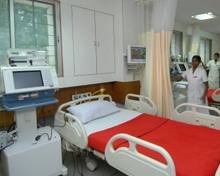Medical Expenses in India
Healthcare turning costlier in India
 Rising corporate culture and the inability of government to
control the drug prices and effectively stem the rising cost of
medical expenses are not good signs for the healthcare system in
India.
Rising corporate culture and the inability of government to
control the drug prices and effectively stem the rising cost of
medical expenses are not good signs for the healthcare system in
India.
Teeming with diverse people (1.2 billion) spread across varying geographical situation, the country is yet to see an efficient healthcare network run by the government that offers curative treatment to the rural folks.
While primary health centres (PHCs), community centres and district hospitals have been stretched beyond their limits and suffer from a plethora of shortages including doctors, nurses and latest equipment, the government is hard put to mobilise resources to upgrade these facilities at the rural areas of the country.
 Even corporate hospitals running facilities in major cities are
loath to spread their wings to rural hinterland as they don’t
want to invest in places where they can’t price their services
up to the bare requirement for running their hospitals on a
profitable basis.
Even corporate hospitals running facilities in major cities are
loath to spread their wings to rural hinterland as they don’t
want to invest in places where they can’t price their services
up to the bare requirement for running their hospitals on a
profitable basis.
National Health Assurance Mission
Prime Minister Narendra Modi's grand vision under the National Health Assurance Mission is expected to extend free drugs and diagnostic treatment to all citizens of the country by March 2019. Besides, this ambitious project will provide insurance cover for serious diseases.
While maintaining a competitive economic growth, India spends just around 1% of its GDP in pubic healthcare as against 3% in China and 8.3% in the US.
Under the National Health Mission, the aim will be on preventive healthcare by ensuring adequate availability of medical professionals in rural areas and at the same time, new infrastructure is being created through the existing programmes by the Centre and state governments.
 This universal health plan reaching out to all citizens of the
country will cost nearly Rs 1.6 trillion in the next four years,
according to senior health ministry officials.
This universal health plan reaching out to all citizens of the
country will cost nearly Rs 1.6 trillion in the next four years,
according to senior health ministry officials.
However, experts warn that it could take decades before India's 1.2 billion are fully covered and the total cost of healthcare coverage would have to face upward revision by many times.
Of late, thousands of small private clinics and hospitals have come up in major towns cashing in on high demand for a range of medical services because of poor public health institutions. According to a PwC-Nat Health report, these small private players have opened nearly 80% of new hospital beds from 2002-2012.
Articles on Health
- Laparoscopic Surgery Advantages
- Laparoscopic Surgery History
- Laparoscopic surgery Procedures
- Limitations of traditional laparoscopic surgery
- New technologies for advance laparoscopic surgery
- Non-Robotic Laparoscopic Surgery
- Robotic Laparoscopic Surgery
- Causes and remedy for dark circles in females

- Harmful impact of mobile phone on unborn baby

- Maternal health care tips

- Rheumatoid Arthritis is Most Widespread in Female
- Periodontal ailment during Pregnancy
- Anemia is prevalent in Women
- Effect of Cell phone tower radiation on human health

- Current health scenario india
- Government health policies india
- Medical facilities india
- Hospital infrastructure india
- Shortage of Medical Professionals in India
- Quality standards indian hospitals
- Indian states health statistics
- Medical expenses india
- Hospitals in Ahmedabad
- Hospitals in Bangalore
- Hospitals in Chennai
- Hospitals in Cochin
- Hospitals in Delhi
- Hospitals in Hyderabad
- Hospitals in Kolkata
- Hospitals in Mumbai
- Hospitals in Pune
- Hospitals in Coimbatore
- Hospitals in Kochi
- Orthopaedics Hospitals in India
- Diabetology Hospitals in India
- Cardiology Hospitals in India
- Infertility Hospitals in India
- Neurology Hospitals in India
- Paediatrics Hospitals in India
- Nephrology Hospitals in India
- Oncology Hospitals in India
- Antiaging foods to improve skin

- Tips for Maintaining healthy bones
- Guidelines for preventing heart disease
- Tips to reduce eye strain while working on computer
- Mental health problems among elderly people
- Health problem of piles

- Health advices for air travel

- Dealing with Allergies
- Tips for Eyes Care
- Care for Crystal Clear Skin
- Tips For Healthy Hair
- Healthy Living is The Absolute Measure of Happiness
- Let Fragrance Rule Your Summer
- Most common vestibular disorder

- Osteoporosis Risk Factors
- Dengue

- Endocrine disorder

- Causes of liver damage
- Dry eye syndrome
- Kidney Stones
- Conjunctivitis: Irritating eye disease
- Anxiety Disorder
- Causes of Brain Damage
- Hepititis B
- Knowledge of Osteoarthritis
- Mental Illness
- Back Pain
- Sugar Addiction
- Diet Control Plans
- General Motors Diet Plan
- No Carbohydrate Diet
- One day Diet Plans
- Seven day diet Plans
- Vegetarian Diet
- Food for Health
- Genetically Modified Foods
- Healing Effects Of Fruits
- Vegetables That Heal
- Healing Effects Of Spices and Herbs
- Test your Stress Level
- Mantras for Relaxation & Stress free life
- Take walk For a healthy body and mind
- Squint is frequently observed in Children
- Consult-Doctor
- Free Handy Health Advice